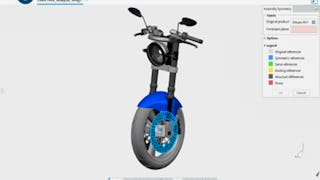“Machine Design Part I” is the first course in an in-depth three course series of “Machine Design.” The “Machine Design” Coursera series covers fundamental mechanical design topics, such as static and fatigue failure theories, the analysis of shafts, fasteners, and gears, and the design of mechanical systems such as gearboxes. Throughout this series of courses we will examine a number of exciting design case studies, including the material selection of a total hip implant, the design and testing of the wing on the 777 aircraft, and the impact of dynamic loads on the design of an bolted pressure vessel.

Gain next-level skills with Coursera Plus for $199 (regularly $399). Save now.

(2,212 reviews)
Skills you'll gain
Details to know

Add to your LinkedIn profile
7 assignments
See how employees at top companies are mastering in-demand skills

There are 5 modules in this course
In this week, we will first provide an overview on the course's content, targeted audiences, the instructor's professional background, and tips to succeed in this course. Then we will cover critical material properties in design, such as strength, modulus of elasticity, and the coefficient of thermal expansion. A case study examining material selection in a Zimmer orthopedic hip implant will demonstrate the real life design applications of these material properties. At the end of the week you will have the opportunity to check your own knowledge of these fundamental material properties by taking Quiz 1 "Material Properties in Design."
What's included
11 videos4 readings2 assignments1 discussion prompt
In week 2, we will review stress, strength, and the factory of safety. Specifically, we will review axial, torsional, bending, and transverse shear stresses. Please note that these modules are intended for review- students should already be familiar with these topics from their previous solid mechanics, mechanics of materials, or deformable bodies course. For each topic this week, be sure to refresh your analysis skills by working through worksheets 2, 3, 4 and 5. There is no quiz for this week.
What's included
8 videos10 readings1 assignment
In this week we will first cover the ductile to brittle transition temperature and stress concentration factors. Then, we will learn two critical static failure theories; the Distortion Energy Theory and Brittle Coulomb-Mohr Theory. A case study featuring the ultimate load testing of the Boeing 777 will highlight the importance of analysis and validation. Be sure to work through worksheets 6, 7, 8 and 9 to self-check your understanding of the course materials. At the end of this week, you will take Quiz 2 “Static Failure.”
What's included
9 videos12 readings1 assignment
In week 4, we will introduce critical fatigue principles, starting with fully revisable stresses and the SN Curve. Then, we discuss how to estimate a fully adjusted endurance limit. Finally, a case study covering the root cause analysis of the fatigue failure of the Aloha Airlines flight 293 will emphasize the dangers of fatigue failure. In this week, you should complete worksheets 10, 11 and 12 as well as Quiz 3 “Fully Reversed Loading in Fatigue.”
What's included
8 videos10 readings1 assignment
In this last week of the course, we will cover the fatigue failure criteria for fluctuating and randomly varying stresses, including key concepts such as the Modified Goodman line and Miner’s Rule. This week be sure to complete worksheets 13 and 14 as well as Quiz 4 “Fluctuating Fatigue and Miner’s Rule.” Finally, take Quiz 5, “The Comprehensive Quiz”, which will measure your overall knowledge of this course.
What's included
8 videos10 readings2 assignments
Instructor

Offered by
Explore more from Mechanical Engineering
 Status: Free Trial
Status: Free TrialDassault Systèmes
 Status: Free Trial
Status: Free Trial Status: Preview
Status: PreviewGeorgia Institute of Technology
 Status: Preview
Status: PreviewGeorgia Institute of Technology
Why people choose Coursera for their career




Learner reviews
2,212 reviews
- 5 stars
83.31%
- 4 stars
14.82%
- 3 stars
1.08%
- 2 stars
0.31%
- 1 star
0.45%
Showing 3 of 2212
Reviewed on Jul 1, 2020
It is really a good course to revise and go out through the basics.But the most annoying part is that the change of the title and the corrections btw the videos and my suggestion is to change it.
Reviewed on Mar 15, 2020
This course was extremely good as my basics were weak and this course helped me to build it up from the foundation. I learned about a lot of new things and in a very calm manner.
Reviewed on Jul 27, 2017
Great review for degreed ME that has not worked in this particular field since college. I would like to see more courses from Dr. Wingate-both in other areas and more advanced.
Frequently asked questions
To access the course materials, assignments and to earn a Certificate, you will need to purchase the Certificate experience when you enroll in a course. You can try a Free Trial instead, or apply for Financial Aid. The course may offer 'Full Course, No Certificate' instead. This option lets you see all course materials, submit required assessments, and get a final grade. This also means that you will not be able to purchase a Certificate experience.
When you purchase a Certificate you get access to all course materials, including graded assignments. Upon completing the course, your electronic Certificate will be added to your Accomplishments page - from there, you can print your Certificate or add it to your LinkedIn profile.
Yes. In select learning programs, you can apply for financial aid or a scholarship if you can’t afford the enrollment fee. If fin aid or scholarship is available for your learning program selection, you’ll find a link to apply on the description page.
More questions
Financial aid available,





